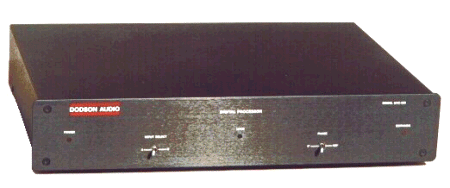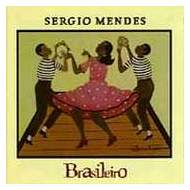You are reading the older HTML site
Positive Feedback ISSUE
18
march/april 2005
dodson audio
DAC-263 DAC
as reviewed by Fown-Ming Tien

FOWN-MING TIEN'S SYSTEM:
LOUDSPEAKERS
ELECTRONICS
SOURCES
CABLES
ACCESSORIES
|
Having a lot of high-end gear in my system has been both a blessing and a curse. As the saying goes, ignorance is bliss. Just six months ago, I was perfectly content with the sound of my system. If I had not heard components that stirred my soul, I would have continued to enjoy my setup, blissfully ignorant of the existence of better components, but as I write this review, I am dissatisfied with every piece of equipment I own. In just one instance, my Modwright Level-2-modified Perpetual Technologies P-3/A DAC, which had faithfully served as my reference for two years, no longer draws me into the music, and the reason is that I heard the Dodson DA-218 DAC. This was fortunate, because until I heard the DA-218, I had no idea how musical a world-class digital front end could sound. It was also unfortunate, because at nearly $8000, the DA-218 carried a much heftier price tag than I could manage!
This set me off on a relentless pursuit to obtain aural nirvana from a digital source that I could afford. I tried the Benchmark DAC-1, which was both excellent and affordable, but it did not add any more magic to the music than my P-Tech rig. I tried the Onix CD-1 CD player, but again felt that it was a lateral step. I was exchanging my single scoop of vanilla ice cream for a single scoop of chocolate—it was the same amount of ice cream, just a different flavor. Like every kid in an ice cream parlor, I wanted more! Nevertheless, I was not greedy. The Dodson DA-218 represented a banana split with hot fudge, caramel, and all the toppings, but I felt I could be satisfied with a two-scoop ice cream cone. The logical step was to consider Dodson's much more affordable offering, the $2795 DAC-263.
Before diving into the technical details of the DAC-263, I should say a few words about Ralph Dodson. I believe that he is a genius when it comes to music reproduction in the digital domain. His expertise lies in digital circuitry and power supply design, and he spent thirty years working for General Dynamics, designing military-spec equipment used in fighter jets and missile controls. Designing high-performance equipment is not new to him. When CD players first became available, Dodson was disappointed with their sound, but believed they had potential that could be realized. He embarked on a journey to improve the quality of digital playback in his own system, and fortunately for us, what began as a hobby turned into a full-time business. Dodson's digital creations take us as far away from the usual grain, glare, and other unnatural-sounding artifacts as any that I have experienced.
The DAC-263 is a 24-bit digital-to-analog converter that up- and oversamples to 768kHz. It takes all digital signals, from satellite TV to Redbook CDs to DAT tapes and DVD-Audio, and upsamples them to 96kHz. The data is then sent to a digital filter, where it is oversampled eight times to a headspinning 768kHz, with a 24-bit word length. The 263 uses custom-made shielded and cryogenically-treated Quantum Noise Filters in its power supply, to lower the noise floor and increase dynamics and resolution. The entire chassis is damped, and a Faraday shield completely surrounds the digital circuits on the circuit board, to shield the analog circuits from digital RFI.
Aesthetically, the Dodson DAC-263 does not appear special. There is no thick, shiny, eye-catching faceplate. The front panel holds two toggle switches, one of which serves as the input selector and the other of which inverts phase. An LED in the center lights up when the DAC locks onto a signal. On the left side of the panel is a red power LED. The red-and-white Dodson logo is silkscreened on the upper left side. A glance at the rear panel reveals an IEC receptacle for the power cord, a coaxial digital input and an optical digital input. A third AES/EBU digital input is a $300 option. Analog output is handled by one pair of XLR connectors and one pair of RCAs. Apparently, most of the cost of the DAC-263 went into the internal components.
Dodson makes it a point to mention that his DACs are very sensitive to transports, power cords, and digital cables, and I have to agree. After trying the Audience PowerChord, the Venhaus Audio Flavor 3, and the Eichmann eXpress6 Series 2, I found that my Electraglide Reference Tri-Glide worked best with the 263. The digital cables I experimented with included an Aural Thrills with WBT Nextgen copper connectors, a Venhaus Audio Pulsar with silver Nextgens, an Empirical Audio Bitmeister digital cable, and a coaxial interconnect that Ralph Dodson insisted that I try. I found Dodson's homemade digital cable to be the best of the bunch. Compared to my Perpetual Tech setup, the Dodson DA-263 delivered more of everything, from the highest of highs down to the lowest of lows.
It was immediately apparent from spinning track one of Diana Krall's Live in Paris CD in my Audio Alchemy DDS-Pro CD transport that the Dodson DA-263 was more refined and detailed in the highs. The cymbals had better focus, speed, and control. Separation and clarity were raised a notch or two. Brightness and harshness are often byproducts of treble detail, but the little Dodson did not exhibit these traits. Highs were smooth and crystal clear, with plenty of air and transparency. The timbre of percussion instruments was accurate, with lifelike attack and decay.
I heard similar improvements in the midrange, which translated as more body and texture in Diana Krall's voice. There was a reduction in the digital hardness and grit that I heard in my own DAC. Skipping forward to "East of the Sun (and West of the Moon)" allowed me to evaluate the 263's midrange capabilities with piano, one of the most difficult instruments to reproduce accurately. With some digital playback systems, piano notes not only have an artificial, digitally-induced iciness, but also sound flat, choppy, and two-dimensional. The flatness comes from lack of texture and layering, while the choppiness stems from premature decay. With the 263, piano notes flowed with a rhythmically natural fluidity.
 To
evaluate the Dodson's midbass, I popped in Rachael Yamagata's Happenstance
CD. The second track has bass from the kick drum and from low piano notes. It
sounded extremely clean, tight, and extended. I then threw in "Keep The Bugs Off
Your Glass and the Bears Off Your Ass," from These Are the Vistas by The
Bad Plus. The Dodson had no problem resolving the fast-moving upright bass
lines. Again, the bass was tight, dry, and extended, with no overhang. Lesser
DACs experience congestion and sound strained when asked to deal with this track
at volume, resulting in a collapsed soundstage and a smearing of notes.
To
evaluate the Dodson's midbass, I popped in Rachael Yamagata's Happenstance
CD. The second track has bass from the kick drum and from low piano notes. It
sounded extremely clean, tight, and extended. I then threw in "Keep The Bugs Off
Your Glass and the Bears Off Your Ass," from These Are the Vistas by The
Bad Plus. The Dodson had no problem resolving the fast-moving upright bass
lines. Again, the bass was tight, dry, and extended, with no overhang. Lesser
DACs experience congestion and sound strained when asked to deal with this track
at volume, resulting in a collapsed soundstage and a smearing of notes.
On Norah Jones' Come Away With Me, the Dodson delivered a warmer, more engaging, and ultimately more involving sound than my Modwright-modded P-3/A and the Benchmark DAC-1. Jones' voice had more palpability and fullness, and the other DACs could not match the Dodson's level of refinement. Compared to the tube-like Onix CD-1 CD player, the 263 was smoother, but because it was not quite as weighty, it sounded slightly more recessed. Before hearing the DAC-263 in my system, I did not feel that the midrange of the Onix CD-1 was grainy, but after hearing the Dodson, the Onix's grain was apparent. The Dodson's high- and low-frequency performance, and its level of detail and control, easily bested that of the $1500 Onix player.
 With
the DAC-263, the soundstage was wider and deeper on Sergio Mendes' Brasiliero
than it had been before. The Dodson's soundstage extends far beyond the
boundaries of my speakers, giving musical performances more realism, especially
with classical music. Gil Shaham's performance of Vivaldi's The Four Seasons
took on new life. Notes sprang from the strings of his violin in the sprightly
movements of "Spring." Sweet notes lingered in the heavy air of "Summer." By the
time "Autumn" rolled around, falling leaves were being blown away in the breeze.
The tempestuous storms of "Winter" raged like never before!
With
the DAC-263, the soundstage was wider and deeper on Sergio Mendes' Brasiliero
than it had been before. The Dodson's soundstage extends far beyond the
boundaries of my speakers, giving musical performances more realism, especially
with classical music. Gil Shaham's performance of Vivaldi's The Four Seasons
took on new life. Notes sprang from the strings of his violin in the sprightly
movements of "Spring." Sweet notes lingered in the heavy air of "Summer." By the
time "Autumn" rolled around, falling leaves were being blown away in the breeze.
The tempestuous storms of "Winter" raged like never before!
As good as the Dodson DA-263 sounded, it did not drop my jaw like the DA-218. The 263's images were not as full, intense, or robust. The bass, while very good, was not thunderous. Of course, the 263 costs $4200 less, and it is not fair to ask the lower-end Dodson to match its big brother. To put things in perspective, the DA-263 is easily the best stock DAC I have heard in the under-$3K price range. Compared to Dodson's former flagship DAC, the DA-217MkII, the DA-263 is leaner, but has a more detailed and refined top end, and its bass is cleaner and tighter, with less overhang.
While I had the DAC-263 on hand, I received a Sony DVP-S7700 that had been highly modified by Steve Nugent of Empirical Audio. Using it as a transport, I heard big differences between it and my transport. The soundstage deepened even further, and the highs became even smoother, with additional improvements in detail. Bass was tauter, with even more extension. True to Ralph Dodson's words, the CD transport can make a huge difference with his DACs.
I also had an Esoteric DV-50 in my possession, and could not resist comparing the 263's performance on DVD-A and Redbook with Steve Nugent's incredible transport to that of the DV-50. The combination came close to the level of the two-channel performance delivered by the DV-50. The highs were remarkably similar, though the highly regarded DV-50 held the upper hand ever so slightly. The lows were also very similar, with the DV-50 again coming out slightly ahead. The area in which the DV-50 had the most distinct advantage was in the midrange. Vocals had a more weight and were just a bit more involving, though not quite as forward as they were with the DA-217MkII.
The Dodson DAC-263 delivered exactly what I had hoped it would—two scoops of premium ice cream! If you are salivating for more from your digital front end, be sure to treat your taste buds to an audition of the two-scoop DAC-263. It might permanently change your diet! Fown-Ming Tien
DAC-263
Retail: $2795
Dodson Audio
web address:
www.dodsonaudio.com
